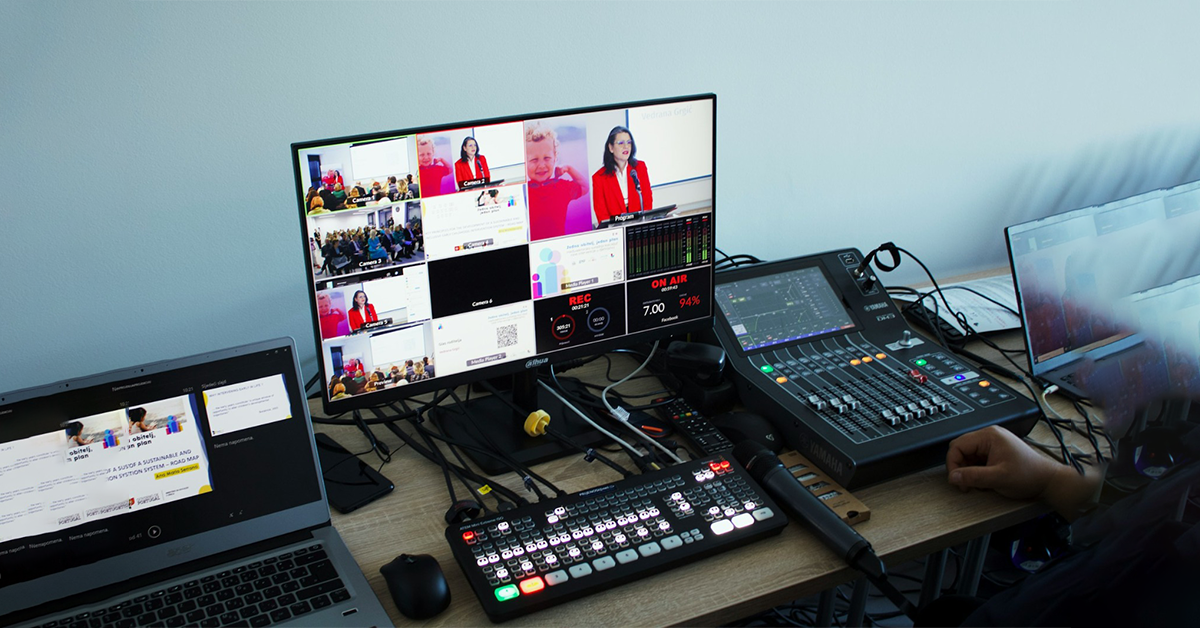So you’ve hosted a successful webinar, but now what? How can you measure its impact and gather valuable insights for future improvement? Look no further than comprehensive reporting for webinar success. By analyzing key metrics such as attendee engagement, attendance rate, and feedback, you can gain a deeper understanding of your webinar’s effectiveness and make data-driven decisions to enhance your future events. In this article, we will explore the importance of comprehensive reporting and how it can pave the way for webinar success.
Unlock the Secret to Flawless Webinars – Contact Virtual Studio Today!
Understanding the Importance of Reporting
When it comes to hosting webinars, reporting plays a crucial role in determining their success. Without proper reporting, it becomes difficult to gauge the effectiveness of your webinars and make necessary improvements. Reporting provides valuable insights into attendee behavior, engagement levels, and the impact of your promotional efforts. By analyzing the data collected through reporting, you can identify areas of improvement and tailor your webinar strategy accordingly.
Why Reporting Matters for Webinar Success
Reporting serves as a valuable tool for measuring the success of your webinars. It provides a comprehensive overview of various metrics that are essential for evaluating the performance of your webinars. By tracking these metrics, you can quantify the impact of your webinars on your target audience and the overall success of your marketing efforts. Reporting also helps you identify potential issues and areas for improvement, ensuring that your webinars deliver maximum value to your audience.
Using Reporting as a Tool for Improvement and Growth
Reporting goes beyond just measuring success; it also serves as a powerful tool for improvement and growth. By analyzing the data collected through reporting, you can gain valuable insights into attendee behavior and preferences. This information can then be used to refine your webinar strategy, create more engaging content, and enhance the overall experience for your audience. Furthermore, reporting allows you to identify trends and patterns that can help optimize your future webinar planning, ultimately leading to better audience engagement and increased success.
Measuring the Impact of Webinars through Reports
Reports provide a comprehensive view of the impact your webinars have on your target audience. By analyzing key metrics such as attendance goals, registration to attendance ratio, participant demographics, and engagement metrics, you can measure the effectiveness of your webinars in attracting and retaining attendees. Additionally, reporting allows you to link webinar attendance with sales conversion, helping you understand the role of webinars in your overall sales funnel. This information is invaluable for measuring the ROI of your webinars and making data-driven decisions to optimize your sales strategy.
Getting Started with Webinar Reporting
To get started with webinar reporting, it is important to have a clear understanding of the key components involved. An overview of webinar reporting provides insight into the various metrics and data points that should be tracked. Understanding these components will enable you to set up your webinar reporting system effectively and determine the key metrics that will be included in your reports.
An Overview of Webinar Reporting
Webinar reporting involves collecting and analyzing data related to various aspects of your webinars. This includes metrics such as attendance, registration to attendance ratio, participant demographics, engagement metrics, performance of promotional channels, and more. By tracking these metrics, you can gain a deeper understanding of the effectiveness of your webinars and identify areas for improvement.
How to Set Up Your Webinar Reporting System
Setting up a webinar reporting system requires careful planning and implementation. First, you need to determine the tools and software that will be used for data collection and analysis. There are various webinar reporting tools available, each with its own features and capabilities. Choosing the right software for your needs is crucial to ensure accurate and comprehensive reporting. Once you have selected the appropriate software, you can start setting up the necessary tracking codes and integrations to collect the data you need.
Determining the Key Metrics for Webinar Reports
To create effective webinar reports, it is important to determine the key metrics that will be tracked. Key metrics may include achieving attendance goals, analyzing registration to attendance ratio, understanding participant demographics, measuring engagement through questions, comments, and participation, and assessing the performance of your promotional channels. By identifying these key metrics, you can ensure that your webinar reports provide the necessary insights to measure the success and impact of your webinars.
Key Metrics For Webinar Reporting
To effectively measure the success of your webinars, it is essential to track and analyze key metrics. These metrics provide valuable insights into various aspects of your webinars and help you understand their impact on your target audience. By tracking these key metrics, you can make data-driven decisions to optimize your webinar strategy and enhance audience engagement.
Achieving Attendance Goals
One of the primary metrics for webinar reporting is achieving attendance goals. This metric measures the number of attendees who registered for your webinar and compares it to the number of attendees who actually attended. By tracking this metric, you can determine the effectiveness of your marketing efforts in attracting and convincing people to attend your webinars. If you consistently fall short of your attendance goals, it may indicate the need to refine your promotional strategy or improve the perceived value of your webinars.
Analyzing Registration to Attendance Ratio
Another important metric for webinar reporting is the registration to attendance ratio. This metric calculates the percentage of registrants who actually attended your webinar. A high registration to attendance ratio indicates strong interest and engagement from your target audience, while a low ratio may suggest that you need to improve your pre-webinar communication or provide more compelling reasons for attendees to join. Analyzing this metric can help you identify areas for improvement and increase the effectiveness of your webinars.
Understanding Your Audience: Participant Demographics
Participant demographics provide valuable insights into the composition of your webinar attendees. By tracking metrics such as age, gender, location, and industry, you can gain a better understanding of your target audience and tailor your webinar content and messaging accordingly. For example, if you find that a significant portion of your audience consists of professionals from a specific industry, you can create webinars that address their unique needs and challenges. Understanding your audience demographics allows you to deliver more personalized and relevant content, resulting in higher engagement and satisfaction.
Engagement Metrics: Questions, Comments, and Participation
Engagement metrics are crucial for understanding how well your webinars resonate with your audience. Tracking metrics such as the number of questions asked, comments made, and level of participation can help you gauge the level of engagement and interest during your webinar. High levels of engagement indicate that your content and delivery are effectively capturing and retaining your audience’s attention. On the other hand, low engagement may indicate a need to improve your presentation or offer more interactive elements to keep attendees engaged.
Performance of Your Promotional Channels
Measuring the performance of your promotional channels is essential for optimizing your webinar strategy. By tracking metrics such as the number of registrations and attendees generated from each channel, you can identify which channels are most effective in driving webinar sign-ups. This information allows you to allocate your marketing resources more effectively, focusing on the channels that consistently deliver the best results. Additionally, monitoring the performance of your promotional channels helps you identify potential areas for improvement and refine your marketing tactics to attract a larger audience.
Implementing Webinar Analytics
Webinar analytics play a crucial role in gaining real-time insights into attendee behavior and preferences. By utilizing analytics tools, you can track and analyze various data points to optimize your webinar strategy and enhance audience engagement. Real-time analytics provide immediate feedback that can be used to make on-the-spot adjustments and ensure that your webinars are delivering maximum value to your audience.
Importance of Real-time Analytics in Webinars
Real-time analytics provide instant feedback on attendee behavior and engagement during your webinars. By monitoring metrics such as attendance, engagement levels, and audience participation in real-time, you can identify any issues or areas for improvement as they happen. Real-time analytics enable you to make immediate adjustments to your presentation, address attendee questions or concerns, and adapt your content to better meet the needs of your audience. This level of responsiveness not only enhances the overall webinar experience but also maximizes audience engagement and satisfaction.
Understanding Audience Behavior through Analytics
Analytics tools allow you to gain a deeper understanding of how your audience interacts with your webinar content. By tracking metrics such as click-through rates, time spent on each slide, and the most popular features used by attendees, you can identify patterns and trends that can help you optimize your webinar strategy. For example, if you notice that attendees are spending more time on certain slides, you can focus on those topics in future webinars or provide additional resources to further explore those areas of interest. Analytics provide valuable insights into audience behavior, enabling you to tailor your webinars for maximum impact.
Linking Webinar Attendance with Sales Conversion
One of the most significant benefits of webinar reporting and analytics is the ability to link webinar attendance with sales conversion. By tracking the number of attendees who convert into paying customers, you can measure the direct impact of your webinars on your sales funnel. This information allows you to quantify the ROI of your webinars and make data-driven decisions to optimize your sales strategy. Furthermore, by analyzing the behavior of attendees who convert, you can identify the key factors that contribute to successful sales conversions and replicate those tactics in future webinars.
Qualitative Metrics in Reporting
While quantitative metrics provide valuable data for measuring the success of your webinars, qualitative metrics offer additional insights into attendee satisfaction and user experience. By collecting feedback through post-webinar surveys and evaluating the quality of your webinar content, you can gain a more holistic understanding of your audience’s needs and preferences.
Using Post-webinar Surveys for Feedback
Post-webinar surveys are an invaluable tool for collecting feedback from your attendees. These surveys allow you to gather qualitative insights that cannot be captured through quantitative metrics alone. By asking questions about the webinar content, delivery, and overall experience, you can gain valuable feedback to improve future webinars. Post-webinar surveys also provide an opportunity for attendees to share their suggestions and identify areas for improvement, helping you enhance the overall webinar experience and increase audience satisfaction.
User Experience Feedback
User experience feedback focuses on evaluating the quality of the webinar experience from the attendees’ perspective. This includes aspects such as the ease of registration, navigation within the webinar platform, audio and video quality, and overall usability. By collecting user experience feedback, you can identify any technical issues or usability challenges that may have affected the attendee experience. Addressing these issues can help create a smoother and more enjoyable webinar experience, ultimately increasing attendee engagement and satisfaction.
Assessing the Webinar Content Quality
The quality of your webinar content plays a significant role in attracting and retaining attendees. By assessing the webinar content quality through attendee feedback, you can gain insights into whether your content is valuable, relevant, and engaging. Attendees may provide feedback on the clarity of the presentation, the usefulness of the information shared, and the overall impact of the webinar content. By considering this feedback, you can make necessary adjustments to improve the quality of your webinar content and enhance the overall webinar experience.
Using Reports for Sales Funnel Optimization
Webinars play a crucial role in moving prospects through the sales funnel. By integrating reporting into your webinar strategy, you can gain valuable insights into how webinars contribute to the overall conversion process. Analyzing the role of webinars in sales conversions allows you to optimize your sales funnel and increase the effectiveness of your marketing efforts.
How Webinars Move Prospects through the Sales Funnel
Webinars are an effective tool for nurturing leads and moving them through the sales funnel. By providing valuable content and addressing the specific pain points of your target audience, webinars create an opportunity to build trust and credibility. As prospects engage with your webinars, they become more likely to move further down the sales funnel. By tracking the attendance and engagement metrics of your webinars, you can identify the key touchpoints that drive prospects towards conversion and optimize these stages in your sales funnel.
Analyzing the Role of Webinars in Sales Conversions
Analyzing the role of webinars in sales conversions allows you to understand the impact of your webinars on your overall sales strategy. By tracking the number of attendees who convert into paying customers, you can measure the direct influence of your webinars on sales. Additionally, by analyzing the behavior of attendees who convert, you can identify the key factors that contribute to successful conversions and apply these insights to future webinars. Understanding the role of webinars in sales conversions helps you optimize your marketing efforts, allocate resources more effectively, and increase your conversion rates.
Enhancing Your Sales Strategy with Webinar Insights
Webinar insights, gathered through comprehensive reporting, provide valuable inputs for enhancing your sales strategy. By analyzing attendee behavior, engagement levels, and conversion rates, you can identify the most effective webinar tactics and implement them into your broader sales strategy. For example, if a particular webinar topic consistently drives high attendance and conversion rates, you can create more content around that topic or focus on presenting it to a wider audience. By leveraging webinar insights, you can refine your sales strategy and create more targeted and impactful marketing campaigns.
Optimizing Webinar Strategy with Reporting
Reporting serves as a powerful tool for optimizing your webinar strategy. By analyzing the data and insights gathered through reporting, you can identify areas for improvement, refine your webinar planning, and enhance audience engagement strategies for future webinars.
Building a Better Webinar: Lessons from Reporting
Through reporting, you can identify key learnings and areas for improvement in your webinar strategy. By analyzing attendee behavior, engagement metrics, and conversion rates, you can identify patterns and trends that indicate successful webinar tactics. These insights help you build a better webinar by replicating the elements that resonate with your audience and modifying or eliminating those that do not. Reporting provides a data-driven approach to improving your webinar strategy and creating more compelling and engaging webinar experiences.
Applying Report Results for Future Webinar Planning
The insights gained from reporting should be used to inform future webinar planning. By identifying the most successful webinar topics, formats, and promotional channels, you can focus your efforts on creating webinars that are more likely to resonate with your target audience. Additionally, by analyzing attendee behavior and engagement metrics, you can identify areas for improvement in your content delivery, interactive features, and overall webinar experience. Applying the results of your reports to future webinar planning ensures that each webinar is better than the last, leading to continuous improvement and audience satisfaction.
Improving Audience Engagement Strategies with Reporting
Reporting plays a crucial role in improving audience engagement strategies. By tracking metrics such as questions asked, comments made, and overall participation levels, you can identify engagement gaps and adjust your strategies accordingly. For example, if you notice low levels of engagement during certain parts of your webinar, you can introduce interactive elements to increase attendee participation and maintain their interest. Reporting provides insights into attendee behavior that can be leveraged to enhance audience engagement and create more interactive and memorable webinar experiences.
Sharing Webinar Reports with Stakeholders
Sharing webinar reports with stakeholders is vital for showcasing the success and impact of your webinars. By providing clear and comprehensive report summaries, you can communicate the value of your webinars and gain support for future initiatives.
Why Stakeholder Reporting is Vital
Stakeholder reporting is vital for demonstrating the value and impact of your webinars to key individuals and teams within your organization. By sharing comprehensive reports, you can showcase the success of your webinars, highlight key metrics and insights, and provide evidence of how webinars contribute to organizational goals. Stakeholder reporting helps build trust and credibility, gain support for future webinar initiatives, and secure resources for further webinar investments.
How to Illustrate Webinar Success with Reports
To illustrate webinar success with reports, it is important to present key metrics and insights in a clear and concise manner. Create visual representations such as graphs and charts to showcase attendance goals, registration to attendance ratios, participant demographics, and engagement metrics. Use these visual elements to highlight the positive impact of your webinars and demonstrate how they contribute to the overall success of your marketing efforts. Additionally, include key takeaways and recommendations based on the insights gained from your reports to provide a comprehensive overview of the success of your webinars.
Providing Clear and Comprehensive Report Summaries
When sharing webinar reports with stakeholders, it is essential to provide clear and concise summaries that highlight the key findings. Begin with an executive summary that provides a high-level overview of the success of your webinars, including important metrics and outcomes. Break down the report into sections that cover each key metric and provide detailed insights, using visual elements to support your findings. Clear and comprehensive report summaries ensure that stakeholders can easily understand and appreciate the value and impact of your webinars.
Ready to Captivate Your Audience? Let Virtual Studio Elevate Your Webinar Game!
Tools and Software for Webinar Reporting
To effectively implement webinar reporting, it is important to utilize the right tools and software. Various webinar reporting tools are available, each offering different features and capabilities. Choosing the right software for your needs is crucial to ensure accurate data collection, comprehensive reporting, and efficient analysis.
Overview of Webinar Reporting Tools
Webinar reporting tools provide the necessary infrastructure to collect, track, and analyze data related to your webinars. These tools offer features such as attendee tracking, engagement metrics, conversion analytics, and survey capabilities. Additionally, they integrate with popular webinar platforms to collect data seamlessly and provide comprehensive reporting dashboards. Some popular webinar reporting tools include GoToWebinar, Zoom Webinar, and WebinarJam.
Choosing the Right Software for Your Webinar Reporting
When choosing webinar reporting software, consider factors such as your reporting needs, budget, and integration capabilities. Assess the features and capabilities offered by different software options and determine which ones align with your specific goals and objectives. Consider whether the software offers integrations with your preferred webinar platform and other marketing tools to ensure seamless data collection and analysis. Additionally, evaluate the customer support and training resources provided by the software vendor to ensure you can maximize the value of the reporting tool.
Maximizing Webinar Success with Top Reporting Tools
Maximizing webinar success with top reporting tools requires leveraging the full capabilities of the software. Take advantage of features such as real-time analytics, attendee tracking, and engagement metrics to gain immediate insights into attendee behavior and make necessary adjustments during your webinars. Utilize comprehensive reporting dashboards to analyze key metrics and identify areas for improvement. Furthermore, use the data collected from your reports to refine your webinar strategy, optimize promotional efforts, and enhance audience engagement. By maximizing the use of top reporting tools, you can ensure that your webinars deliver maximum value and contribute to the overall success of your marketing initiatives.
Future Trends in Webinar Reporting
Webinar reporting is a dynamic field that constantly evolves to keep up with changing technologies and audience expectations. Embracing future trends in webinar analytics and reporting will enable organizations to harness the full potential of their webinars, optimize their strategies, and drive even greater success.
Emerging Trends in Webinar Analytics and Reporting
Emerging trends in webinar analytics and reporting include advancements in data visualization, artificial intelligence, and predictive analytics. Data visualization techniques such as interactive dashboards and real-time reporting offer more intuitive and engaging ways to analyze and present webinar data. Artificial intelligence-powered analytics help automate data analysis, identify patterns, and generate actionable insights. Predictive analytics enable organizations to anticipate attendee behavior, personalize webinar content, and optimize promotional strategies. These emerging trends in webinar analytics and reporting empower organizations to make data-driven decisions and create more impactful and engaging webinar experiences.
How AI Can Enhance Webinar Reporting
Artificial intelligence (AI) has the potential to revolutionize webinar reporting by automating data analysis, identifying trends, and generating actionable insights. AI-powered analytics tools can process large amounts of data quickly and accurately, freeing up time for marketers to focus on strategy and decision-making. AI algorithms can help identify attendee preferences, predict attendee behavior, and optimize webinar content to maximize engagement and conversion rates. By leveraging AI in webinar reporting, organizations can gain deeper insights into their audience, enhance the effectiveness of their webinars, and improve overall marketing results.
Preparing for Future Reporting Needs
To prepare for future reporting needs, organizations should stay informed about emerging technologies and trends in webinar reporting. Keep a close eye on advancements in data analytics, visualization techniques, and AI-powered reporting tools. Proactively assess your current reporting infrastructure and consider if it can support future reporting needs. Evaluate the scalability, integration capabilities, and flexibility of your reporting tools to ensure they can adapt to changing requirements. By staying ahead of emerging trends and continuously upgrading your reporting capabilities, you can be well-prepared to meet future reporting needs and drive webinar success.
In conclusion, comprehensive reporting is essential for the success of webinars. Tracking key metrics such as attendance goals, registration to attendance ratio, participant demographics, engagement metrics, and performance of promotional channels provides valuable insights into the impact of webinars. By analyzing these insights, organizations can optimize their webinar strategy, enhance audience engagement, and drive sales conversions. Webinar reporting tools play a vital role in collecting, analyzing, and visualizing data to facilitate data-driven decision-making. By staying informed about emerging trends in webinar analytics and reporting, organizations can leverage advancements in AI and predictive analytics to further enhance their webinar strategy and drive even greater success in the future.
Transform Your Webinars from Bland to Grand – Connect with Virtual Studio Experts!







